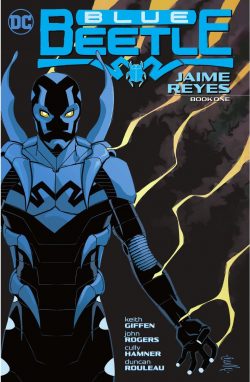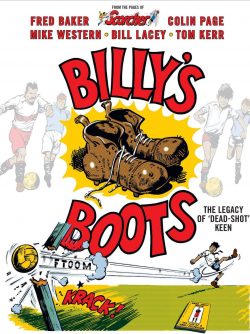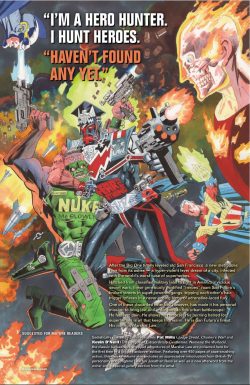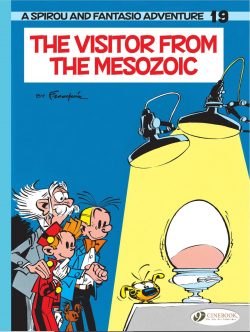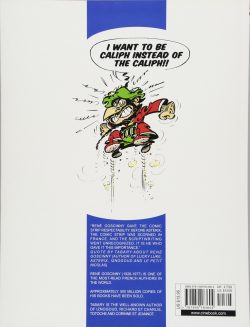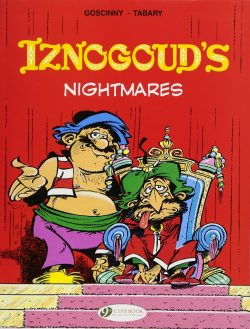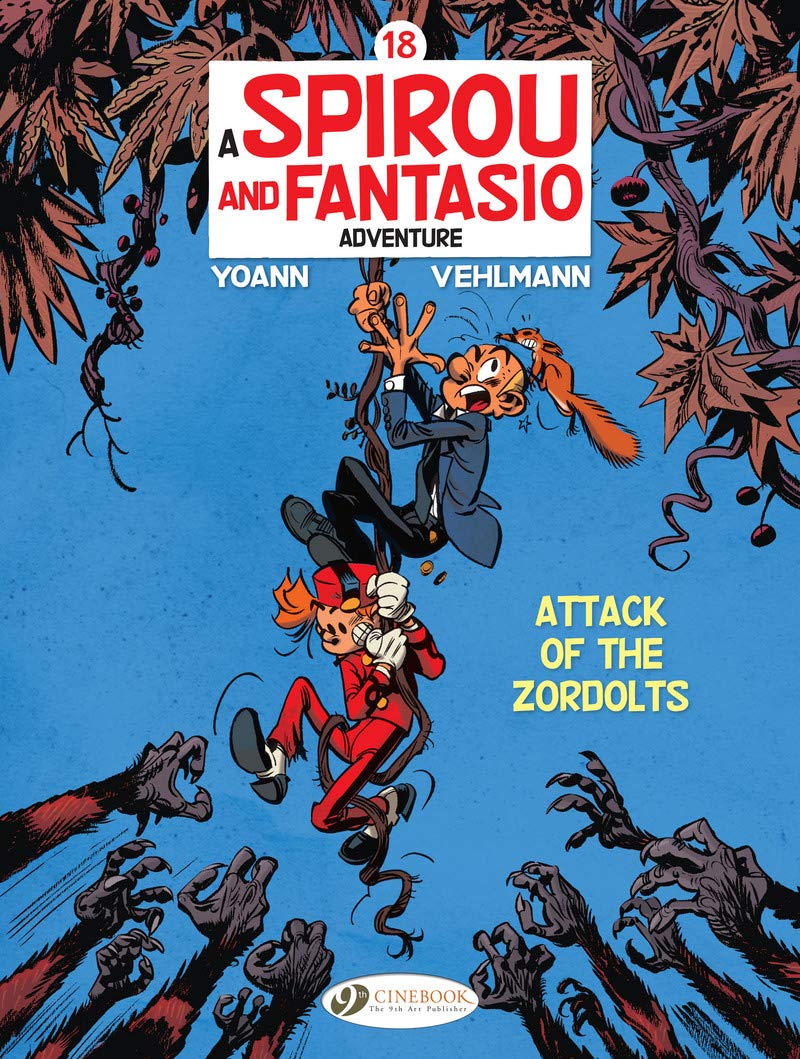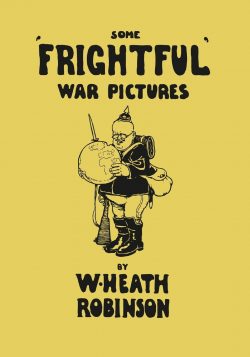
By Sheldon Mayer (DC Comics)
ISBN: 978-1-4012-3112-5 (HB)
Win’s Christmas Gift Recommendation: Utter Entertainment Perfection… 10/10
I actually intended this for a forthcoming week of kid-friendly books in the New Year but on re-reading this gloriously whimsical and hilariously absurdist tome I came to the conclusion that just like its scintillating and ultra-impatient co-star, I am quite impatient and don’t like to share with just anybody, so this is for Right Now …and probably just for the parents, ok?
And just so we’re clear, miss Sugar Plumm predates Miss Piggy by DECADES and is marginally scarier! Okay? Good, now go on, and let the kids see it too if you want…
Sheldon Mayer (April 1, 1917 – December 21, 1991) is arguably the most important man in American comic book history. A writer and cartoonist, he was also the editorial guiding light behinds dozens of major features at All American Publishing, with a hand in the creation of Wonder Woman, The Flash, Hawkman, Green Lantern, Justice Society and many more.
He mentored young creators like Carmine Infantino and Joe Kubert and his creative opinions as assistant to Max Gaines and others dictated the way the entire industry unfolded.
Back in 1935, he was a writer, artist and eventually editorial assistant to Major Malcolm Wheeler-Nicholson at embattled and failing outfit National Allied Publications. In 1938, Mayer was credited with rescuing from the trash can a weird strip about a strongman in tights and a cape. He apparently loved the feature – by two kids named Siegel and Shuster – and pushed until Harry Donenfeld put it in his new anthology Action Comics. That worked out pretty well in the end…
Above all else, Mayer was an inveterate and incurable cartoonist. In 1936, at Dell Comics he created semi-autobiographical boy cartoonist Scribbly, and when “Shelly” joined Gaines at AA he brought that comical kid with him. When the superhero craze truly kicked off, Mayer added one to the strip. Ma Hunkel was Scribbly’s fearsome landlady, and when crime and ne’er-do-wells plagued her neighbourhood, she tackled the problem by making a costume from kitchen scraps and pots to patrol her inner city district as the mighty, mysterious Red Tornado…
In 1948, Mayer surrendered his editorial position to devote himself to drawing and storytelling. He had already spearheaded AA/DC’s move into funny animal features four years previously, in new or converted titles Funny Stuff (Summer 1944), Animal Antics (March 1946) and Funny Folks (April 1946). Cover-dated June 1945, Leading Comics (former home of the Seven Soldiers of Victory) was the first to drop superheroes, becoming an anthropomorphic mainstay with #15.
Mayer’s mirth mountain included the return of Scribbly; exploring the burgeoning teen scene in Leave it to Binky and Buzzy, and generating all-ages whimsy and hilarity in dozens of strips like Doodles Duck, Peter Porkchop, Nutsy Squirrel, Dodo and the Frog and The Three Mouseketeers. In 1956, he created the most charming and adorable comics concept ever published… Sugar and Spike.
The series was an all-Mayer affair that ran 98 issues – until his eyesight failed and he stopped drawing. Undaunted, he carried on as a writer: scripting anthological horror tales for Adventure Comics and sundry DC mystery titles like House of Mystery and Forbidden Tales of Dark Mansion. He also created Black Orchid, revived DC’s 1950s iteration of Rudolf the Red Nosed Reindeer and – following eye surgery – resumed drawing Sugar and Spike for international syndication.
Some of those stories were reprinted in DC digests The Best of DC, and in 1992, a commemorative 99th issue of Sugar and Spike: released as part of the DC Silver Age Classics series. As usual, I’m revelling in nostalgic joys here whilst whining like a baby and opining for DC to commission a full archival revival in print and digitally…
The concept is beautifully simple and evergreen and as a sign of the regard DC held Mayer in, he was allowed to sign his work: an honour only Siegel & Shuster, Bob Kane and Charles Moulton enjoyed at that time.
In in ordinary domestic America, there are two neighbouring families; each with a toddler. Those little kids get up to all sorts of mischief, much of it quite destructive. These kids are like all baby beings – able to clearly communicate with every other infant in creation – but not adults. The premise constantly generates captivating magic as the bright kids daily discover, categorise and classify their world: posit their own soundly rationalistic explanations for the grown-ups’ weird behaviours and fascinating toys and foods (or anything else they can put in their mouths…). Naturally, the adults think the babytalk babble is cute, but surely it’s nothing but charming nonsense?
Preceded by a revelatory Introduction from Comics historian Bill Schelly the wonderment opens right on the cover which introduces Sugar Plumm and Cecil “Spike” Wilson and sets up a regularly recurring gag: although friends and neighbours, the toddlers’ parents have differing approaches to child rearing. Whenever the kids discuss these discrepancies and attempt to capitalise on the parents’ latest tactic (this was the great era of baby advice gurus like Dr. Benjamin Spock), it’s usually Spike who suffers for it…
That premiere issue opens with ‘Sugar and Spike!’ as the Plumm family move in and quickly introduce themselves and their new daughter to the Wilsons. The kids get on like a house on fire, chatting away like old pals, even though it’s the first baby Spike has ever seen and he can’t form proper words yet…
He’s just discovered a universal truth: although everything has to learn its own language, all babies are born able to communicate with each other…
Soon he’s showing the fascinating new creature with the hair tail all the fun places in his house, like daddy’s basement workshop where all the loud fast toys and paint tins are, and despite the resultant chaos triggering the first of many spats between the adults a friendship for the ages is born…
‘Thumbs Up!’ then builds on the front-cover gag as the infants compare notes on how their parents react to thumb-sucking, unaware that there’s more than one baby-care book and varying opinions can produce wildly varying adult responses…
Mayer was well aware that his young readership needed lots of participatory stimulation and worked hard on activity pages such as ‘Write Your Own Comic Page’, wherein kids could fill in blank word balloons of a strip and colour it in afterwards, before ‘Busy Corners’ introduces Sugar’s Uncle Charley. He’s a motorcycle cop and her favourite adult, partly because he rides that bizarre “put-put” thing and partly because he always brings fun (for which read “inappropriate”) toys, but mostly because Uncle Charley never really grew up. Spike is initially jealous but soon warms to the big guy… just before his antics result in both babies and Charley being sent to stand in the corner again…
‘Free Wheeling’ then sees the tots work out the best – but not correct – way to use a wheelbarrow and invent an indoor sport based on golf that has immense destructive potential in ‘The Big Question’, after which their discovery of ‘The Yak-Yak Box’ leads to telephonic disaster. The debut issue then closes with a back-up starring older kid ‘Littul Snoony’, whose dabbling with a junior chemistry set leads to manic misunderstanding…
Sugar and Spike #2 (cover-dated June/July 1956) opens with mystery yarn ‘Photo Finish’ as the plucky lad attacks another baby photographer hired to snap little miss Plumm. The parents can’t understand why cameras terrify Sugar or why Spike always gallantly attacks the lens-jockeys, but that’s because they can’t understand the little lady’s tale of woe about a snake-ejecting trick box during an earlier photoshoot…
Understandable frustration at big people’s inability to understand baby talk boils over during ‘The Return of Uncle Charley’ who comes bearing a water-spurting fire truck and gets them stuck in the corner again, after which ‘Spike at Home’ and ‘Sugar at Home’ prove that the cooperative kids can cause chaos all on their own, before ‘The Big Toy Mystery’ details their discovery of vehicular fun – and folly – after Spike gets a tricycle…
Mayer was always aware that the newspaper comic strip was a powerful and ubiquitous tool used to raise circulation and promote customer loyalty in the 20th century, and as well as laughs, thrills and escapism creators often added games, cut-out collectibles and paper toys to their output. The common belief was that youngsters – especially girls – loved this kind of “dress-up” play, but I suspect many young men also joined in. One of the most popular and perennially effective was beloved characters in their underwear, plus assorted outfits to clothe them in. Many features took the process further by inviting readers to contribute designs.
This practise graduated from the strips to comic books, and Sugar and Spike employed paper-doll pages for its entire run, beginning with a set of cut-out ‘Pint-Size Pin-ups’ (the kids in diapers and six readers’ ensembles from summer dresses to a Davy Crockett suit), after which the kids go to a swish department store where Sugar teaches her “doll-boy” ‘How to Play Loozum’. This issue closes with a ‘Do It Yourself Comic Page!’ where all the characters are faceless and readers can either draw their own or cut and paste from a selection of expressions graciously provided…
For #3, Spike is given a marble by some older kids, but his love for it triggers calamity when it’s eaten by a vacuum cleaner and Sugar makes the monster give back ‘The Shiny Round Roller’, after which ‘Spike Discovers the Ocean!’ and is quickly convinced that it hates him…
More ‘Pint-Size Pin-ups’ lead to a minor masterpiece as the boy is taken to his first restaurant and befriends the main course in ‘Lobsters Away!’ His screams lead to the Wilsons taking the baby crustacean home, where Spike and Sugar resolve to return “Alice” to her home in the ocean…
Activity page ‘You Be the Editor!!’ presents a scrambled strip to put in order – and colour in – before the issue closes with a “kootchy-coo!” monster invading the Wilson home. Happily, Sugar has encountered a “Nanty” before and her ‘Anti-Aunty’ tactics include roping in Uncle Charley to drive the beast away…
Cover-dated October/November, S&S #4 introduced another major theme and recurring gag: the babies’ gradual capitulation to nature and maturation, as epitomised by learning – to say, if not understand – new grown-up words. ‘Who’s Sorry Now?’ sees Spike in the corner when Sugar teaches him a term that makes adults forgive everything. However, when they hear someone apparently abusing the magic term, their vengeance is both fearsome and bizarre…
The tots’ discovery of a ‘New Gadget’ results in utter chaos and necessary redecoration before ‘One Sunday Afternoon’ finds Pa Wilson failing to self-assemble a new garden hammock thanks to their assistance. Staying with recreation, the ‘Water Babies’ are dumped on their dads, and enjoy a fishing trip that borders on the surreal and uncanny…
Sugar and Spike #5 (December 1956-January 1957) opens with the infants attending ‘The Birthday Party’ of an older kid, and utterly misunderstanding the notion of GIVING OTHER PEOPLE presents. This hilarious romp introduced mean bully Clarence: a spoiled older boy continually outwitted by the toddlers over the years.
Insomnia informs ‘The Early Birds’ as the tiny tots go walkabout whilst the parents enjoy the sleep of the exhausted, and Spike ponders ‘Grampa’s Problem’ – a sly observation on the indignities of old age – before more ‘Pint-Size Pin-ups’ anticipate ‘The Mystery of the Funny Runner’ with our curious kids questioning how older kids have wheels on their feet…
They seek to imitate firefighters in ‘To the Rescue’ with unwelcome results before the copy closes with a backyard clean-up that reveals ‘A Place for Everything’ isn’t literal when looking for somewhere to put fallen leaves…
Charm manifests in almost lethal amounts in #6 as the veteran infants meet and bring up to speed a newborn in ‘The New Baby’, and another developmental milestone is reached on ‘The Trip’ as both tots stay with Spike’s grandparents for their first Christmas. That witty wonderment is augmented by a ‘How To Make Sugar and Spike Dancing Dolls’ and more gloriously adorable ‘Pint-Size Pin-ups’, before ‘Winter Sunday’ sees the downside of shovelling snow off sidewalks with curious toddlers joining in and ‘Cats? Meowch!’ explores the hazards of finger painting with anchovy paste. This issue then folds with Spike and Sugar addressing consumerism in combat with all the mod cons (that was “Modern Conveniences” if you’re post Millennial) in ‘Baby vs. Machine’…
By #7 (April/May 1957) Mayer was regularly using fashions contributed by readers, as here in opening yarn ‘Mud Mud Mud!’ when the moms try to split up the kids and Mrs Wilson bribes the local older boys to include Spike in their war games. When their messy roughness provokes a tantrum, Sugar comes to his rescue with shocking consequences but not as much as what happens when the misbehaving tots catch their moms consulting ‘The Magic Book’ that seems to dictate what punishments they get…
The mayhem of Spike’s ‘First Haircut’ came from a plot sent in by two readers, one of whom also designed outfits for another ‘Pint-Size Pin-ups’ section, whilst Mayer can claim full credit for Spike’s close encounter with ‘The Don’t-Touch Thing’ and almost sending his dad to jail from the passenger seat in motorcar moment ‘Three-Wheel Driver’…
Issue #8’s mixes crockery carnage and childish misdemeanours with high concept as the kids give the adults ‘Speech Lessons’ in an attempt to make their moms properly communicate in clearcut babytalk and ‘Uncle Charley Strikes Again’ with another magnificently inappropriate toy for Sugar before a double helping of ‘Pint-Size Pin-ups’ leads to another failed experiment when Sugar ensures that ‘The Tick-Tock Won’t Tick-Tock Now!’
Grandpa then finds a way to replace a hobbyhorse in ‘Ride ‘Em Cowboy’, and we close with more animal antics in ‘Trip to the Zoo’…
Sugar and Spike #9 saw the title shift to a monthly frequency: opening with ‘Double Trouble’ as the infants investigate a strangely familiar couple inside the big glass toy, whilst their wear & tear on toys is tackled by daddy – AKA ‘The Fix-It Machine’, and – after two more ‘Pint-Size Pin-ups’ – ‘Horse Sense’ traces the troubles caused by their first trip to an amusement park where the nippers naturally “liberate” a baby-talking little pony…
Another ‘Write Your Own Comic Page’ then leads to a breakthrough in counting in ‘Spike Learns Big Business’…
This sublime collection concludes with #10 (cover-dated September 1957) beginning with ‘The Big Word Mystery’ as the troublesome toddler parrots a grown-up sound that makes adults go crazy, after which the kids learn that pulling ‘The Magic String’ makes day-time go away.
One last brace of ‘Pint-Size Pin-ups’ leads to another seaside jaunt where the parents go ‘Beach Nuts’ after the kids go AWOL and – once safely home – ‘More Adventures with the Yak-Yak Box’ when Spike tries in vain to rescue the random toddler who answered whilst he was playing with the very-forbidden telephone…
These are wonderful, whimsical stories from a time when comics were a major entertainment medium and the only mass market accessible to kids. Thanks to the gifts of Sheldon Mayer, these yarns remain some of the most beguiling and hilarious ever crafted – just ask the numerous countries the feature was syndicated to – and absolutely MUST be brought back for kids of every vintage to enjoy.
© 1956, 1957, 2011 DC Comics. All Rights Reserved.


